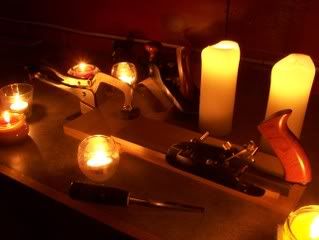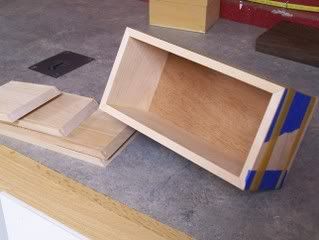Candlelight Woodworking???
Hurricane Hanna paid Maryland a visit this weekend in the form of lots and lots of rain and some wind. Unfortunately in my neighborhood a butterfly flapping it’s wings can knock out the power so with this weather we lost power for most of the day on Saturday and a little on Sunday too.
This power outage threw a monkey wrench into my plans for recording a podcast but ironically with no distractions from TV, power tools, or computer, my wife and I began to get to some of the odd jobs around the house that we have been putting off. Dreaded things like cleaning out “that drawer” in the kitchen or the hall table. Replacing the faucet in the master bath is another one that I finally got to. While cleaning out the hall table drawers my wife said to me, “I need something to keep our pens and pencils in and something for all the extra batteries.”
“I could make a couple of boxes for that if you want” I said. “Of course without power it could be difficult.”
“What about all those hand tools you have been collecting? Do you really need power?” she taunted back.
With that the gauntlet was thrown down and I was not going to back away from this challenge. What I needed to construct were two small boxes with interior dimensions of 3.5″ wide by 8.5″ long. The height needed to be under 3.75″ to fit into the drawer. I hit the scrap pile and found some 6×12 inch pieces of Beech that were all planed to 3/8″ thick. Perfect for this project. My wife asked that one box have a lid to keep our extra batteries and the other box open for all the pens and pencils. I grabbed an extra piece of Spanish Cedar for the pencil box and have a small chunk of Wenge left over that would look cool for the battery box.
Now I am a hybrid woodworker who uses his hand tools primarily for refining joinery and finishing the work I have already done with power tools. In other words all the rough work is done on table saw, band saw, or chopsaw. This became very obvious when I realized the only rip cut saw I have is my Lie-Nielsen tenon saw. Note to self, look for some panel saws at the next flea market. Fortunately with the stock being only 12″ long I was able to rip it to width using the tenon saw. I just had to be creative at the end of the cut by laying the saw down in the kerf so I didn’t run the brass back into the wood. It sure made for a square cut though doing it that way! I was really happy with how close to the line and how square the cut was after cutting all the box pieces. With a quick touch up using the Jack plane I had the pieces to final width and square.
Have I mentioned how disappointed I am at the amount of natural light in my shop? I ended up doing most of this cutting out in the driveway on a small bench that functioned as a saw bench. Well, once I had the pieces cut to final dimensions I needed to cut a groove for the bottom panel and a groove for the top panel on the battery box. At this point it was getting dark but I was having so much fun I decided to press on. I moved back into the shop so I could use my kreg bench clamp and a batten to hold the workpiece while using a plow plane to cut the groove. (I really need to get my workbench built!!) It was pretty dark in there so I lit a whole bunch of candles and went back to work. I think I remember hearing that in Australia they call galoots “dark siders”. Makes sense to me now that I am working literally in the dark!
I often lose myself in my work while in the shop, but this was a new experience that just kept me thinking about the craftsmen that came before me. I was using an old Stanley #3 to smooth the sides of the boxes that I inheirited from my wife’s grandfather. I know for a fact that he got this at a flea market and restored it so who knows how long it has been around and who has used it before me. I’m sure that none of my hand tools were used before the advent of electric lighting, but it was still neat to think of woodworkers before me working by candlelight to get that last little bit of joinery done before calling it a night. It is a humbling experience to say the least.

On Sunday, I started back to work in the shop but the power was back on by this point. I was trying to get some work done on my in progress sharpening station and cutting some drawer bottom panels on the table saw when the power went out again. Oh well, back to my “neanderthal” boxes. With the grooves cut, I used my Carcass saw to cut rough miters at the corners and then refined them on my shooting board for a perfect fit.
By the time I had this done, I realized that the power had come back on but I decided to just keep going by cutting the bottom panel to size. It was at this point that my tools and skills failed me. I cannot think of a way to thickness a panel using only hand power since I don’t currently own a scrub plane and taking 800 passes with my jack plane to reduce a 3/8 panel to 1/8″ thick doesn’t sound like fun. So I broke down and turned on the thickness planer and cheated my way to an 1/8″ panel. As a compromise, I beveled the edges of the panel for a slightly looser fit in the groove to allow for wood movement using my block plane.
Finally, I glued it up and used good ole blue tape to clamp them and then wrapped a few large rubber bands for extra strength.

Here you can see the pencil box glued up and the battery box ready to be glued next to it with the chunk of wenge I plan to use for the top panel on the lid. Now that I have gotten started on these boxes using only hand power I want to finish them out in the same style to see if I can really do it. I just need to figure out a way to cut spline grooves by hand for a little extra decoration at the corners.
Any suggestions?


